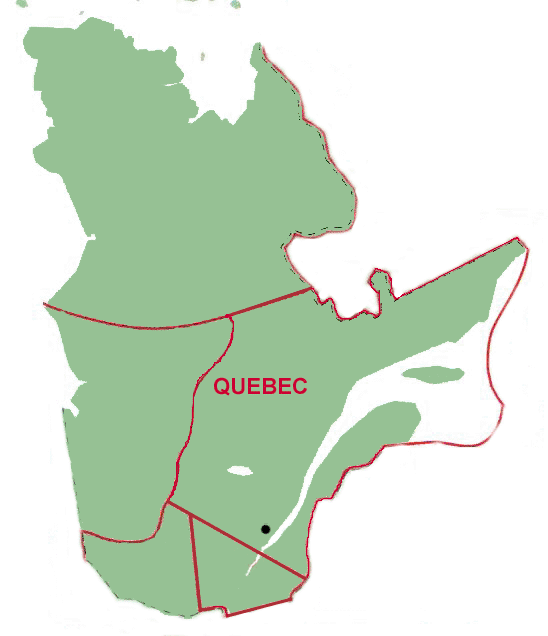Serving a vast territory
Covering an area of approximately 720,000 square kilometers, the Diocese of Quebec is larger in size than France or Afghanistan. The diocesan boundaries stretch from the Magdalen Islands in the east, to Kawawachikamach in the north, and to the Eastern Townships in the south. The east-west boundaries are roughly 900 km apart; the north-south boundaries are approximately 1,100 km apart. On our southern edge, which is at most points the border with the United States, we have a three-parish border ministry shared with the Episcopal dioceses of New Hampshire and Vermont.
Quebec City, Sherbrooke, and Trois-Rivières are the three major urban centres located with our diocesan boundaries. However, in general, the diocese consists of large areas marked by scattered towns and villages. The largest geographical portion of the diocese is home to unfettered wildlife, unseen forest vales, and unnavigated streams, giving a sense of what God’s vast creation looked like centuries ago.
Historic and picturesque Quebec City is the see city of the diocese, with the diocesan offices (Church House) and episcopal residence (Bishopthorpe) located within the close of the Cathedral of the Holy Trinity. The cathedral close is itself situated inside the historic walled Old City of Quebec, which is recognized by the United Nations as a World Heritage Site.
Colonial beginnings
On June 28, 1793, Jacob Mountain was appointed first Lord Bishop of the newly erected See of Quebec by Letters Patent granted by King George III. However, the Anglican presence in what forms the present-day Diocese of Quebec dates from 1759 with the arrival of overland forces under General Amherst and the British navy sailing up the St. Lawrence River. The first recorded service within its territory was one of thanksgiving, held shortly after the battle on the Plains of Abraham. The celebrant was the Rev. Eli Dawson, a naval chaplain, and the service was held in the chapel of the Ursuline convent in Quebec City.
The first permanent pastoral appointments for the civilian population were made in 1768 when three French-speaking clergy were sent from England, to serve at Quebec, Montreal, and Three Rivers, with the intention of proselytizing the local Roman Catholic population. This plan failed, but the life-appointments of these three slowed the progress of Anglican pastoral care until Charles Inglis, Bishop of Nova Scotia, visited Quebec, then part of his vast diocese (erected only two years earlier) in 1789. He assembled the clergy then serving in Upper and Lower Canada, and appointed commissaries to administer each. The first real oversight of present-day Quebec dates from this time.
Bishop Mountain’s diocese extended from New Brunswick and Labrador to the shores of Lake Superior. Successive divisions, beginning in 1839, when the Diocese of Toronto was erected, concluded in 1850. Thus the Diocese of Quebec once comprised the territories of those of Toronto, Huron, Ottawa, Algoma, Niagara and Montreal. Even today it remains one of the most extensive dioceses in Canada.
Since 1793, 13 bishops have served Quebec. The first three were appointed by the Crown; the first to be elected was James William Williams, in 1863. Our Church Society, formed in 1842, is one of only two in Canada still in existence. It acts as a missionary society and plays an important supportive role in the life and work of the church in Quebec. Diocesan Synod, our governing body, dates from 1859.
Provision for theological education locally dates back to 1828, and from 1845 the Faculty of Divinity at Bishop’s University graduated an impressive succession of priests. The faculty voluntarily dissolved itself on the suggestion by General Synod that divinity programs be confined to specific locations across the country. Since 2008 the Diocese of Quebec has enjoyed a formal relationship with Montreal Diocesan Theological College, affiliated with McGill University.
The diocese today
There are approximately 65 congregations, serving an overall Anglican population of approximately 4,000 souls. A handful of those congregations have only one service a year and a few serve only summer parishioners.
The diocese is presently served by approximately 25 priests who are assisted by several deacons and lay readers. The majority of incumbents serve multi-point parishes, and some clergy are engaged in ministry on a non-stipendiary basis.
The census shows that in the Quebec City region less than two per cent of the local population is English speaking. French is by far the language most spoken in the territory covered by the diocese, though there remain important pockets of English speakers in the diocese in the Eastern Townships, Lower North Shore, and Magdalen Islands. Naskapi is the main language spoken by the people of the parish in Kawawachikamach, on the Labrador border.
Roman Catholicism remains by far the largest Christian denomination in Quebec, and relations between the Anglican and Roman Catholic churches in Quebec have historically been strong and warm—and remain so to this day. Living ecumenically is not only a gospel imperative, but in some ways a matter of survival in our diocese. As a result we also work with other churches present in the territory we serve, establishing collaborative relationships with traditions as diverse as the United Church of Canada and the Syriac Orthodox Church in Canada.
As Quebec becomes a more and more pluralistic society, we are also seeking to establish positive relationships with other religious traditions with whom we share this land, such as followers of Judaism, Islam, and Indigenous peoples.


